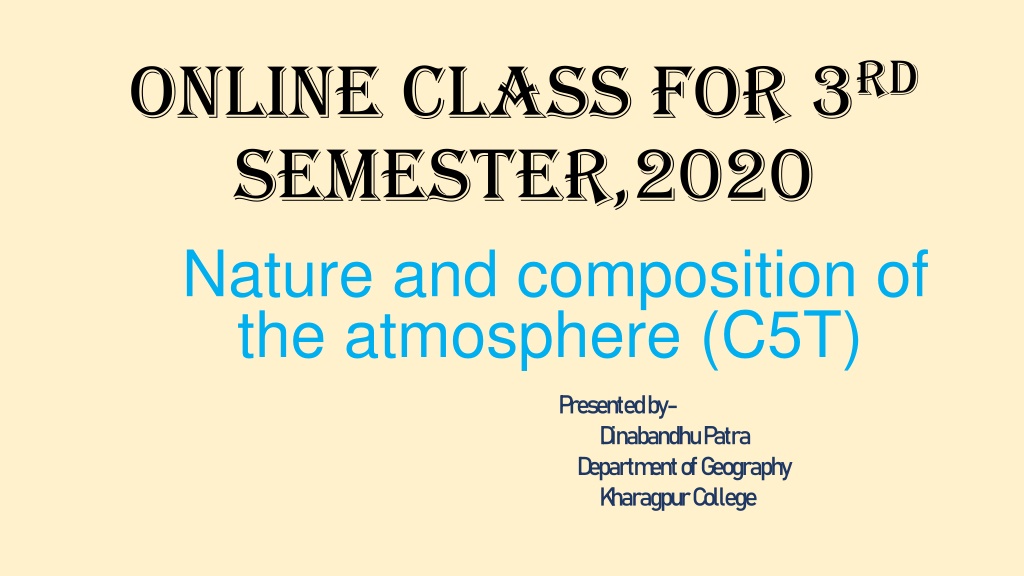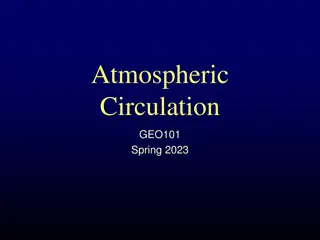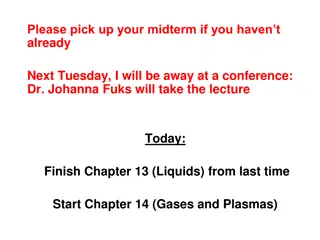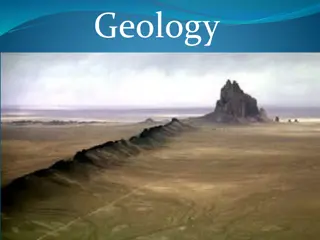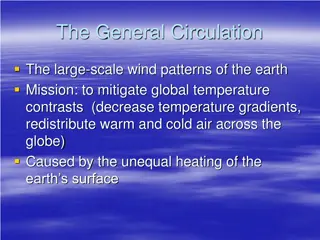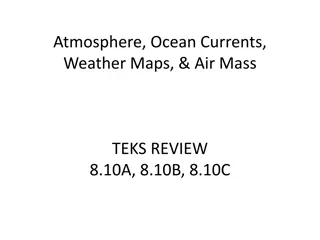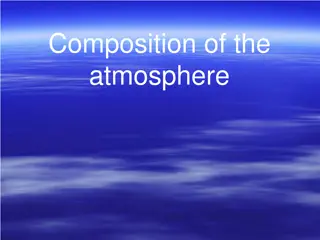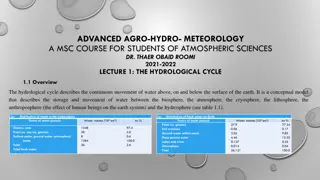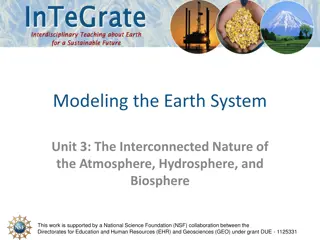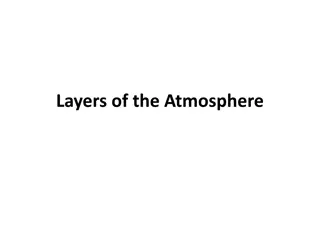Understanding the Nature and Importance of Earth's Atmosphere
Earth's atmosphere is a vital component that supports life on our planet. It is a thin gaseous envelope surrounding Earth, providing essential elements for living beings. The composition and development of the atmosphere have evolved over billions of years. The atmosphere plays a crucial role in protecting Earth from space projectiles, regulating temperatures, supporting agriculture, and maintaining the balance of different ecosystems.
Download Presentation

Please find below an Image/Link to download the presentation.
The content on the website is provided AS IS for your information and personal use only. It may not be sold, licensed, or shared on other websites without obtaining consent from the author. Download presentation by click this link. If you encounter any issues during the download, it is possible that the publisher has removed the file from their server.
E N D
Presentation Transcript
ONLINE CLASS FOR 3RD SEMESTER,2020 Nature and composition of the atmosphere (C5T) P resented by- D inabandhu P atra D epartm ent of G eography K haragpur C ollege
Atmosphere The atmosphere can be defined as a relatively thin gaseous envelope surrounding of earth. The earth is surrounded by like a blanket of air called atmosphere. The atmosphere Is a reservoir of several essential elements for all living beings on this earth. Ninety-nine percent of the gases that compose the atmosphere are located below a height of 32 km. In the atmosphere, there are concentric layers of with different density. The upper layers have a continuous pressure on the lower one so, the lower layer is always much heavier or denser and the upper layers are thinner or less dense. Fig-1: High reflectance of Blue in sky and atmosphere Image Source: https://phys.org/news/2019-12-breathable- atmospheres-common-universe-thought.html
Development of Atmosphere: Development of Atmosphere: The early atmosphere of the Earth is very different from the atmosphere today. Scientists believe that the Earth was formed about 4.5 billion years ago and the atmosphere probably formed from the gases given out by volcanoes. It also believed that there was intense volcanic activity for first time of the Earth's existence. The early atmosphere was probably mostly carbon dioxide, with very little or no oxygen. There were also smaller proportions of water vapour, ammonia and methane. As the Earth gradually cooled down, most of the water vapour condensed and formed the oceans. The composition became changed, proportion of oxygen went up because of photosynthesis by plants Carbon di oxide goes down because it locked up in sedimentary rocks (such as limestone) and in fossil fuels. There were Changes came in the atmosphere . Information source: http://wwwhttps.bbc.co.uk/bitesize/guides
Some important properties of atmosphere: Some important properties of atmosphere: The atmosphere exchanges very little mass and momentum with space- a open system. The total dry mass of the atmosphere calculated in some research as an annual mean, is nearly to be 5.13 X lO8 kg. Water vapor accounts for roughly 0.25% of the atmosphere by mass. Every elements in the atmosphere has their own specific character. Atmosphere maintains the heat balance in different latitude through the air movement. Vertically, from earth surface to upward there are some layer of atmosphere with different composition. The temperature is diversified in Different stratum of atmosphere.
Importance of atmosphere: The atmosphere is an absolutely indispensable environment for all the life forms on earth, without it the Earth would be a lifeless planet. Some major side of Atmospheric importance is mentioned below- Earth's atmosphere protects us from incoming space projectiles (comets, asteroids) that burn up before reaching the planet's surface. It blocks harmful short wavelength radiation come from the Sun. Atmosphere has enormous effects on agricultural productivity; it controls human needs in production. Important process of hydrosphere and lithosphere is maintained by Atmospheric activity. Very minor level of Compositional change would be harmful for life forms on the earth.
Composition Of Atmosphere Composition Of Atmosphere Major constituents of dry air Element Formula % By Volume The composition of Earth's atmosphere is largely governed by the by-products of the life that it sustains.The atmosphere contains many gases, most in small amounts, including some pollutants and greenhouse gases. The most abundant gas in the atmosphere are nitrogen, oxygen and Argon.Some recent measure shows that amount of Co2 is increased up to 0.041361 % by volume. N2 Nitrogen 78.084 O2 Oxygen 20.94 Ar Argon 0.93 CO2 Carbon dioxide 0.037 Neon Ne 0.0018 Helium He 0.0005 Ozon O3 H2 0.00006 Hydrogen 0.00005 Krypton Kr 0.0011 Source: https://en.wikipedia.org/wiki/Atmosphere_of_Earth & Barry, R. G., & Chorley, R. J. (2009). Atmosphere, weather and climate. Routledge. Xenon Xe 0.00009 Methen CH4 0.00017
Cont Cont The permanent gases whose percentages do not change from day to day are nitrogen, oxygen and argon. Water vapour lies in moist air, varies place to place. The relative concentration of gases remains constant until about 10,000 m (33,000 ft). Air is polluted due to introduction of chemicals, particulate matter or biological materials into the atmosphere, that cause harm or discomfort to organisms. Composition of Atmosphere Nitrogen Oxygen Argon Carbon dioxide Neon Helium Ozon Hydrogen Krypton Xenon Methen
A. Primary gases: A. Primary gases: Air is a mechanical mixture of gases, not a chemical compound. In dry air, by volume, nitrogen and oxygen is composed more than 99 per. Various observations show that these gases are mixed in remarkably constant proportions up to about 100 km altitude. Inspire of predominance, these gases are of little climatic importance (Barry & Chorley, 2009). B. Greenhouse gases: The greenhouse gases play a crucial role in the thermodynamics of the atmosphere. Human are strongly affected by this gasses. 1. Carbon dioxide (CO2): Carbon dioxide is supplied into the atmosphere by plant and animal respiration, from the earth s interior , the decay of organic material, volcanic eruptions, and natural and anthropogenic combustion. carbon dioxide is removed from the atmosphere by photosynthesis and dissolving in the sea. The imbalance between emissions and uptake by the oceans and terrestrial biosphere leads to the net increase in the atmosphere (Barry & Chorley, 2009).
2. Methane (CH4): Methane is produced primarily through anaerobic processes. Any natural wetlands and rice paddies field. Almost two-thirds of the total production is related to anthropogenic activity. Methane production- CO2 +4H2 CH4 + 2H2O Destruction of Methane-CH4 + O2 + 2x CO2 + 2x H2 where x denote to any specific methane destroying species (e.g. H, OH, NO, Cl or Br etc.). Some scientist believes that destroying all methane can lead to ice age in earth. 3. Nitrous oxide (N2O): Source of production is by nitrogen fertilizers , industrial processes, transportation, biomass burning, cattle feed lots and biological mechanisms in the oceans and soils. It is destroyed by photochemical reactions in the stratosphere.
4. Ozone (O3): Atmospheric ozone is a minor, permanent and natural component of the atmosphere. It produced through the breakup of oxygen molecules in the upper atmosphere by solar ultraviolet radiation . Ozone can regenerate automatically in Stratosphere. C. Reactive gas species: In addition to the greenhouse gases, important reactive gas species are produced by the cycles of sulphur, nitrogen and chlorine. These are play key roles in acid precipitation and in ozone destruction (Barry & Chorley, 2009).
D. Aerosols: Aerosol is the Small solid particles and liquid droplets in the air. There are significant quantities of aerosols in the atmosphere. These are suspended particles of sea-salt, mineral dust (particularly silicates), organic matter and smoke. They serve as condensation nuclei for cloud formation. Aerosols enter the atmosphere from a variety of natural and anthropogenic sources. These are like soil grains, mineral dust, carbon soot, biomass burning and volcanic dust etc. E. Water vapor: Water vapor is supplied to the atmosphere by evaporation from the surface and is removed from the atmosphere by condensation (clouds and rains). Water vapour comprises up to 4 per cent of the atmosphere by volume (about 3 per cent by weight) near the surface (Barry & Chorley, 2009). In tropical area generally it is little high (~ 0.25% of the atmosphere by volume) and decreases rapidly toward higher altitudes and latitude (~ 0% of the atmosphere).. Water vapor is important to climate because it is a greenhouse gas that can absorb thermal energy emitted by Earth.
Based on concentrations of gases of gases atmosphere is classified- A. Homosphere: The homosphere is the layer of an atmosphere where the bulk gases are homogeneously mixed due to turbulent mixing or eddy diffusion. Troposphere, stratosphere and mesosphere together constitute the homosphere. It extent Upto 80 - 100 kM altitude from surface. B. Heterosphere: The heterosphere is the layer of an atmosphere where the gases are separated out by molecular diffusion with increasing altitude. Here lighter species become more abundant relative to heavier species. It extent beyond 80 kM altitude. Some features are- Heavier molecules (N2, O2) are at lower altitude and lighter ones (H2, He) at higher altitude) Atoms/molecules are accelerated by solar radiation Due to rarity, they rarely collide.
References: References: 1. Barry, R. G., & Chorley, R. J. (2009). Atmosphere, weather and climate. Routledge. 2. https://en.wikipedia.org/wiki/Atmosphere_of_Earth 3. http://tornado.sfsu.edu/geosciences/classes/m201/Atmosphere/Atmosphe ricComposition.html 4. https://www.ess.uci.edu/~yu/class/ess5/Chapter.1.composition.all.pdf 5. http://www.phys.ufl.edu/~katia/Teaching/MET1010/Lectures/Chapter01b. pdf
